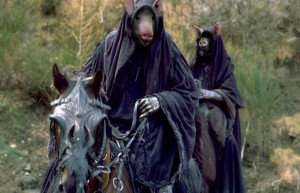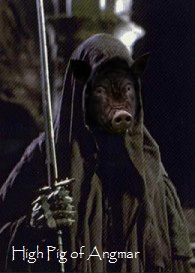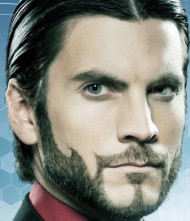My kids are finally old enough to watch Jackson’s The Fellowship of the Ring! Naturally, I excavated the extended version ( I ‘d carefully sheltered it from the family DVD bin that accelerates the laws of entropy), and we had a family movie night.
Watching it, however, I relived my initial disappointment with its world building at the level of sound. Specifically, I found myself rolling my eyes when the Black Riders showed up. Why? Because the sound engineers had an opportunity to imply worlds of weirdness with the sounds emanating from the ringwraiths, but instead used what has become the clip art of scary monster sounds — the high-pitched squeal of pigs.
Clip-Audio
It’s everywhere. Think about it. The sound of velociraptors in Jurassic Park? Pig screams. The six-armed invaders from Cowboys and Aliens? Pig screams. The weird proto-alien-squid monster aborted from the heroine of Prometheus? Pig screams! The mile-high Kaiju of Pacific Rim? Freaking pig screams! It doesn’t seem to matter if the creature is as big as the Empire State Building or as small as a terrier, it’s going sound like a psycho pig.
It’s as if the last time anyone put any effort into world building on the level of sound was when William Friedkin recorded the screams of pigs herded for slaughter for use in The Exorcist. Back then, this sound was original and brilliant and effective. Now it is the clip-audio of monster sounds. It’s as if Friedkin’s feat of sound imagination was so awe-inspiring that even Peter Jackson could find nothing more appropriate for the ghosts of the ancient kings of Middle Earth than the sound of shrieking swine.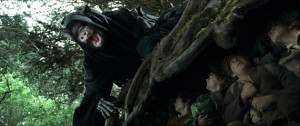 (To be clear, I don’t know if he actually recorded pigs, per se–chances are a synthesizer could create it from scratch–but the two are virtually indistinguishable.)
(To be clear, I don’t know if he actually recorded pigs, per se–chances are a synthesizer could create it from scratch–but the two are virtually indistinguishable.)
I wish I could dub Teletubby tracks over it; I swear that would be scarier. (Or imagine a velociraptor making Teletubby sounds… Gives me a shiver!)
Visual Trumps Audio
I have to assume that Hollywood is so “visually” focused that it undervalues the value of sound in world building. But when I refer to sound as an element of world building, I think of it as a visual component. For example, when Legolas draws his funky elvish blade, and it goes schwing! in a perfect C major, I visualize clean, honed, shining steel. When the orc draw’s its blade it better not sound the same. For that we’ll need a gritty, metal-on metal scrape, so we visualize a rusted, blood-caked machete of a blade, which implies as much of orc culture as the schwing does of elves. (Wait…Okay, you know what I mean.) My point is this: sound choice can economically imply layers of visual detail, just as word choice can in prose.
What if the Audio had been as Brilliant as the Visuals?
Consider the layers of eerieness one could imply about the bizarre half-life of the ringwraiths if their sounds had instead been alluring or musical, like mournful pipe organs? Or flatly metallic? Or distant whispers like urgent messages heard through a long pipe? Or if they’d been utterly soundless/sound devouring as in Joss Whedon’s wonderful Buffy episode, “Hush?”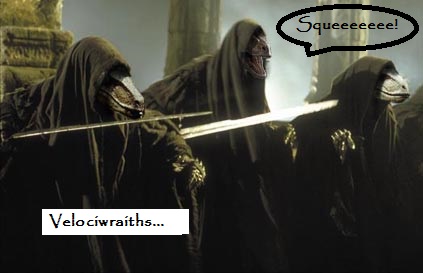
But no one does that any more. Even Cameron and his visually resplendent bioluminescent Avatar forests used the pig-scream clip-audio for the calls of his four-eyed flying mounts. (Look out! Flying pigs!) The aliens in Whedon’s Avengers were apparently from a pig planet, too. Those aliens, along with the invaders in Aliens and Cowboys, are obviously of highly intelligent, technologically advanced species, yet they had no discernible language or patterned vocalizations other than pig screams. And while I’m thinking of it, the advanced race of squid-headed aliens in Independence Day? Pig screams.
Bright Spots in Hollywood Monster Audio?
1) District 9’s aliens! Huzzah!
2) … ( Anyone…? Anyone…?)
Turn it Upside Down
Instead of striving for something “scary” sounding (sounds that are harsh, threatening, violent), I humbly suggest we do the opposite. Try giving the monster a voice that is lovely, or even ridiculous. Ever hear the voice of America’s favorite bad ass raptor, the American Bald Eagle? It’s not the haunting Kii! Kii! dubbed in for its appearance in Hollywood films or Colbert’s title sequence (that cool sound is actually the sound of a red-tailed hawk). The bald eagle’s voice is the fruity piping of a seagull on crack: “Keetle- KEETLE-keetle! Keetle-KEETLE-keetle!”
Hard not to giggle, the first time you hear it. But give that sound to a monster as it tugs the guts out of someone’s family dog, and the discordance would be quite chilling.
In less than a week we get to see The Desolation of Smaug and find out what the spiders in Mirkwood sound like! …Anyone want to make a guess?
Please let it be Teletubbies.


